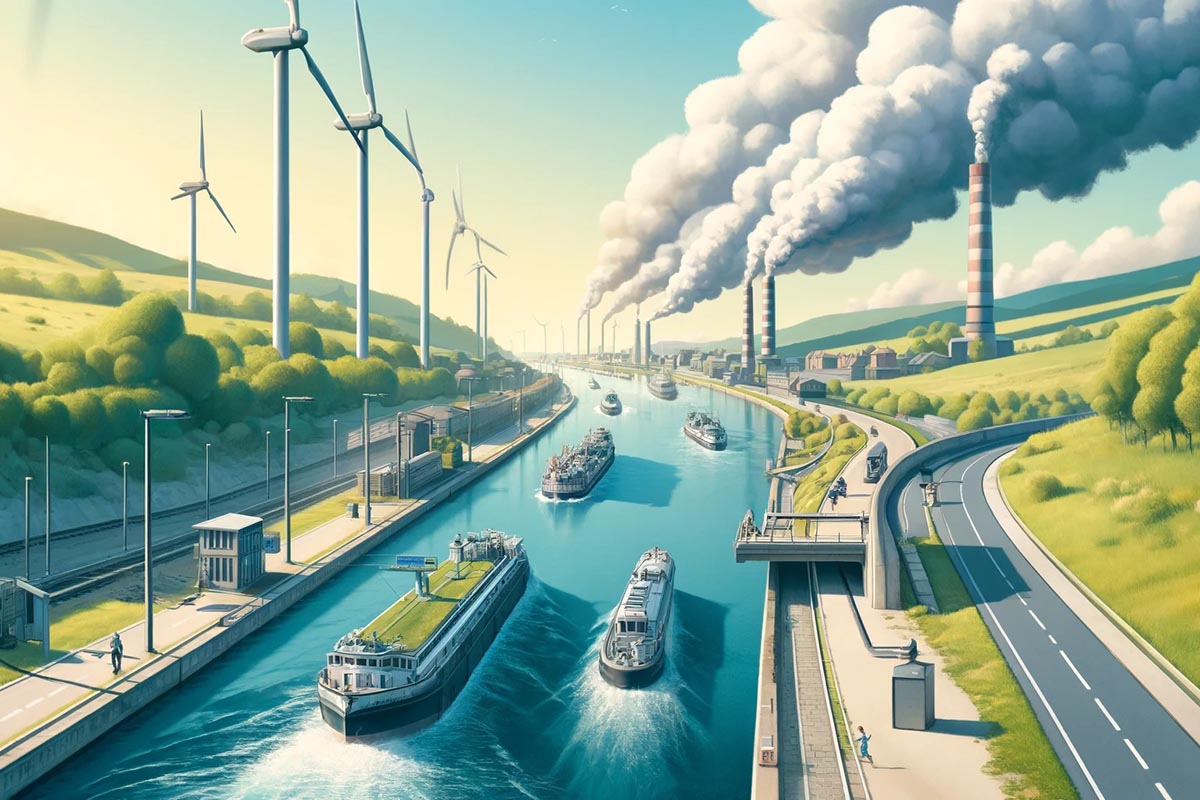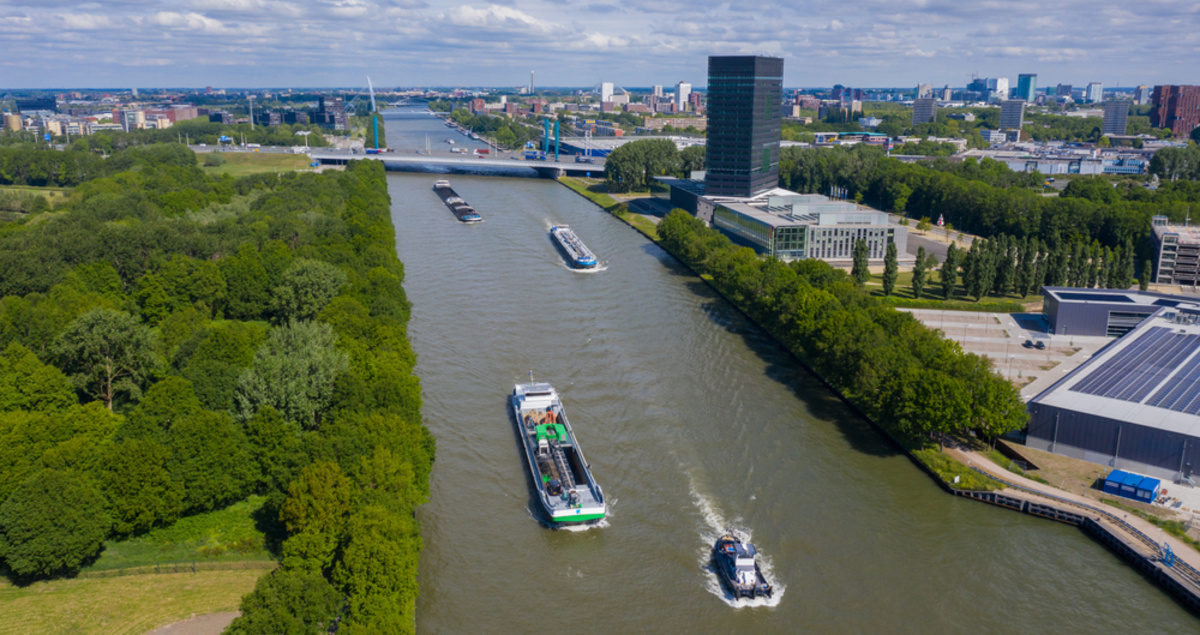River transport, essential to trade and logistics in Europe, is at the dawn of a new era with hydrogen as the main vector of decarbonization. From prototypes of hydrogen boats to innovative engines, the sector is resolutely committed to sustainable mobility.
Whether along the Rhine, the Danube or the Rhône, river transport is a key driver of trade and logistics in Europe.
Challenges to overcome for a successful transition
Despite the enthusiasm, the transition to hydrogen in European river transport is fraught with obstacles, particularly in terms of costs, regulation and support for shipowners. The joint efforts of governments, industry and regulators are crucial to overcoming these challenges.
In addition, transporting goods by ship is more efficient in terms of CO₂ emissions per tonne than road or rail transport, according to the European Union, which plans to transfer more goods in this way. However, while European inland navigation vessels are relatively environmentally friendly, there is still work to be done to decarbonize their propulsion.
According to Morten Brix, managing director of Mitsubishi Turbocharger and Engine Europe (MTEE), a Mitsubishi Heavy Industries (MHI) group company, inland waterway transport is under increasing pressure to move away from diesel as a base fuel, both from European and national regulators as well as from customers wishing to clean up their supply chain.
By switching to hydrogen, ships using inland waterways can both minimize emissions and limit air and water pollution.
A standardized but fragmented market
Currently, we estimate that there are about 15,000 boats on this river network. These vessels, like those in the road transport sector, are more or less standardised so that they can navigate all waterways and the points of interconnection between them,” explains Morten Brix.
Each vessel has a lifespan of 30 to 50 years, but some can last up to 80 years, says Mr Brix. They are usually powered by powerful diesel engines, which need to be replaced two or three times during the vessel’s life.
Mr Brix adds that owners need to be sure that they are future-proofing their vessels. This is particularly important as inland navigation has a high proportion of single vessel owners – often families who also live on their vessels – and small fleets.
Low-carbon options for waterways
As these shipowners face big investment decisions, there are a range of alternatives to diesel to consider – primarily fuel cells and internal combustion engines that use hydrogen or methanol instead of diesel.
As Brix explains, battery technology is not yet competitive for inland waterways. While batteries can be used for short distances, they are not yet feasible for long-distance waterway transport due to their limited range. And the cost is still high, he adds. The same goes for fuel cells, which can cover greater distances but are not yet economically viable.
“In the next five to 15 years, we believe internal combustion engines (ICEs) capable of switching from diesel to hydrogen will have a better chance of success.
In the short term, Brix adds that MTEE expects methanol to be an option as a transition fuel for these engines, before they switch to hydrogen. “At the moment we are at the diesel stage, then at the methanol stage for the next seven or eight years, before hydrogen really starts to take off,” he explains.
A smooth transition from diesel to hydrogen
The move from diesel-powered internal combustion engines to methanol and then to hydrogen engines is a relatively minor change compared to other technology options. Internal combustion engine technology has long been used in inland navigation – with experience spanning more than 50 years – and is easy to adapt, says Brix.
“We take one of our proven diesel engines as a starting point and modify the fuel injection system so that the engine can run on hydrogen. We try to change the current configuration of the engine room as little as possible. machines, so that the transition is smooth and efficient.
However, the ships will also need to be modified in other areas, including fuel storage and piping. Additionally, hydrogen is still much more expensive than diesel at present – especially green hydrogen, which is made entirely from renewable energy.
However, the price of hydrogen is expected to fall as the renewable energy industry grows. Stricter carbon taxes and penalties will also play a role, Brix adds.
Supporting shipowners
With the technological and regulatory roadmap still very open and future costs difficult to predict, it is essential to help shipowners prepare their fleet for the future.
Mr Brix draws attention to the Dutch government’s ambitious mobility programme, which has allocated 47 million euros ($52 million) to develop electrification and hydrogen applications. As part of this program, MTEE is expected to install its first hydrogen engine on a ship in 2025.
In addition to converting ships to low-carbon fuels, the Dutch mobility program is also exploring aspects such as fuel bunkering along European rivers to allow ships to refuel regularly en route. This is important for maximizing cargo capacity, as the lower energy density of hydrogen compared to diesel means it will take up more physical storage space on board.
Regulation and classification
As with much of the energy transition, frameworks governing alternative fuels such as hydrogen are still in their infancy.
Mr Brix recalls that the EU is currently working on regulations to realize its vision of a carbon-free river transport system in Europe. Similarly, Bureau Veritas, which classifies and certifies ships for insurance purposes, only recently published its first classification rules for hydrogen-powered ships. These rules include safety requirements for managing the flammability of hydrogen and special storage needs.
Creating these regulatory frameworks will be key to ensuring shipowners make the right decisions when it comes to protecting their vessels for the future.
To support shipowners in this transition, government programs, such as that of the Netherlands, play a key role by financing the development and installation of hydrogen engines. These initiatives, coupled with the establishment of regulatory frameworks by the EU and classification bodies such as Bureau Veritas, are essential to prepare the sector for a carbon-free future.
The transition to hydrogen in European river transport is both an opportunity and a challenge. With the right support, the continent’s waterways could become a model of sustainable transport, contributing to society’s overall goal of decarbonization. The road is mapped out, but the collaboration of all stakeholders will be decisive to succeed in this green transformation.



